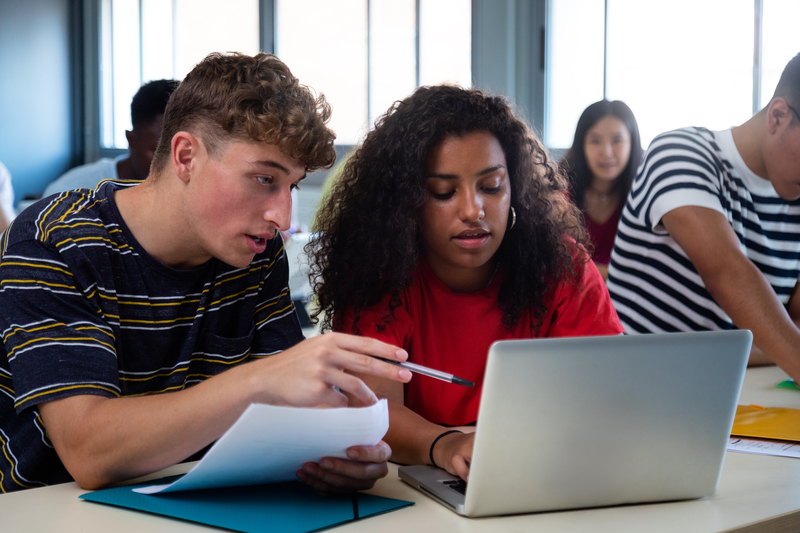There is nothing like seeing a child find a favorite book. When children discover a story that serves as a mirror of their lives or reminds them of a friend, a genuine connection develops. Teachers and caregivers who work with children to find these stories create an environment that empowers students to develop their own reading identities.
In our work as professionals at Scholastic, we spend a lot of time with teachers and their students and books to observe what leads kids to the stories they love. We've seen a student who did not initially enjoy reading become curious about the books his classmates discussed with one another. He became a reader because of conversations with peers about interesting topics, access to books, and the friendships he formed over stories.
1. Make the classroom library a priority.
Children who have robust classroom libraries are more likely to be frequent readers (Scholastic). Classroom libraries increase access, and the more access kids have, the more they read. The more they read, the more they achieve. Research shows that reading as a leisure activity is the best predictor of comprehension, vocabulary, and reading speed (Krashen, 1993).
Classroom libraries also promote choice, which is empowering. We should be selecting from classroom libraries for read-alouds and independent reading both in school and at home.
2. Cultivate diverse and wide-ranging selections.
We must be deliberate about serving students a breadth of texts. The following elements are essential for a library:
Diversity: As our classrooms and our country become increasingly diverse, we know that kids want more information about the world around them. This information can be as broad as the globe or as personal as their family and friends. It's not enough just to care about diversity; we must consistently expand the types of stories included in our classroom libraries and continuously define what we mean by "diverse." The Kids & Family Reading Report shows that about half of kids ages 9–17 and parents overall wish there were more diverse books available to them. Guides such as The Children's Book Council's list of recommendations and The Power of Story catalog, as well as Twitter and Instagram resources such as #TheBookChat, #1000BlackGirlBooks, @booksfordiversity, and @weneeddiversebooks, are places to start. Strong characters: Four in 10 kids agree that there has been a character in a book whose story taught them a life lesson (Scholastic). Access to many authentic voices helps students see themselves in books and develop empathy for others.
Fiction and nonfiction: Books of all types are incredibly valuable sources of information. According to Scholastic, 74 percent of kids say that reading both fiction and nonfiction helps them understand the world, and 53 percent say a book has helped them through a difficult time.
Multiple formats: Comic books and graphic novels have a unique appeal. They are nearly as popular among frequent, moderate, and infrequent readers. Magazines are another format greatly preferred by infrequent readers. These formats may be the only opportunities for some students to experience joy while reading because they can take in content in small excerpts and pictures. Classroom libraries can also offer e-books and audiobooks, bookmarks, author videos, posters, pictures, and other items that generate excitement around reading.
3. Find ways to engage a striving reader.
Research by the Annie E. Casey Foundation has shown that reaching reading proficiency by 3rd grade is a clear predictor of academic success, but it is also around age 9 that children's frequency of reading books for fun begins to drop, according to the Kids & Family Reading Report. By valuing student input, making sure kids have highly engaging texts, and offering choice with guidance, we can reverse the "decline by 9." Just putting a book in a child's hands is a valuable step—visual literacy counts! Pictures are a starting point for interacting with a text and break down what may be overwhelming for a reader. Introducing books in new formats and media, such as podcasts, author interviews, and audiobooks, is another strategy for sparking interest among readers who may not be so eager.
We should also encourage reluctant readers to talk with us about books, including why they may not want to read a given title and what topics they want to read about. When we allow kids to vent about their reading frustrations, we shift the conversation in a way that addresses their concerns and redirects to engagement.
4. Guide, don't control, children's choices.
Interactions with educators, family members, and peers inform what kids read. It's our role as educators to shine a light on reading materials we think they may be interested in. Most kids agree their favorite books are the ones that they have picked out themselves. While we should be talking with students about books, we also have to let them advise how we can better help them find books on their passions and interests. What if we specifically asked students what books they'd like to see?
Students' reading preferences will evolve, and so should libraries in order to address those interests.
Administer surveys to students on topics of interest throughout the school year.
Invite families to share what they know about their children.
Talk to librarians for insights on trends and new releases.
Follow other literacy educators on social media to learn about titles that are resonating with kids.
A Year for the Books
It's one thing to have a classroom library, but it's also about what we do with it. Our support must begin the moment a child enters the classroom for the first time—from learning about their interests to making sure that they have access to the texts they want and need. All decisions we make contribute to the learning environment, so students must be our priority as we build our classroom libraries all year long.







